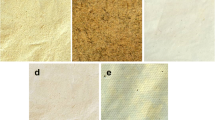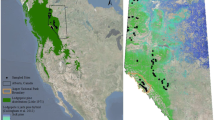Abstract
The biochemical responses to varying levels of localized heat damage to stems and crowns were studied in Pinus pinaster trees in Galicia, Spain. The objective was to ascertain the utility of secondary metabolites (total polyphenols, condensed tannins, astringency, free and esterified phenolic acids) and pigments (chlorophylls and carotenoids) as chemical indicators of localized fire damage. The study involved three levels of girdling by trunk heating (0%, 60%, and 75%), three levels of crown scorching (0%, 50%, and 75%), and all combinations of those trunk and crown treatment levels. Secondary metabolites and pigments were analyzed in needles before, during, and up to 8 months after fire treatments. High levels of polyphenols, condensed tannin, and pigments occurred in situations where the sole treatment was 75% crown scorching. Low levels of hydroxycinnamic acids were the result when the treatment was 75% trunk girdling. These responses occurred in the first two months after fire. Thereafter, normal values were observed. Low values of chlorophyll a/b ratio and high levels of free protocatechuic and esterified syringic acids were found to be long-term indicators of trunk girdling damage combined with crown scorching.
Similar content being viewed by others
REFERENCES
AllÚe, J. L.1990. Atlas Fitoclimático de España. Taxonomía. MAPA Monografías INIA No. 69, 222 pp.
Alonso, M., and BarÁ, S.1989. Análisis comparativo del contenido de ácidos fenólicos libres en hojas y horizonte A0 de suelo de Eucalyptus globulus, Pinus pinastery Quercus robur. Comunicaciones INIA. Serie Recursos Naturales No. 49, 47 pp.
Alonso, M., BarÁ, S., and Vega, J. A.1993a. Ácidos fenólicos como parámetros bioquímicos indicadores de stress en viveros de Pinus pinaster. Invest. Agrar. Sist. Recur. For.2:85–196.
Alonso, M., BarÁ, S., and Vega, J. A.1993b. Efecto del incendio y fuego prescrito sobre el porcentaje relativo de terpenos en Pinus pinaster. I Congreso Forestal Español, Lourizán, Ponencias y Comunicaciones, Tomo III, pp. 167–172.
Alonso, M., Rozados, M. J., Vega, J. A., BarÁ, S., and CuiÑas, P.1998. Parámetros químicos indicadores de daños producidos por fuego en Pinus pinasterAit: Nutrientes, capacidad buffer, iminoácidos y compuestos fenólicos. Invest. Agrar. Sist. Recur. For.7:5–27.
BarÁ, S., Alonso, M., and vega, J. A.1990. Mùtodos biofísicos para establecer el estado fisiológico de especies forestales. Comunicaciones INIA. Serie Recursos Naturales No. 56, 103 pp.
BarÁ, S., Vega, J. A., and Alonso, M.1992. Estudio de los daños producidos por el fuego en árboles utilizando métodos bioeléctricos I. Pinus pinaster. Invest. Agrar.Sist. Recur. For. 1:21–40.
BarÁ, S., Vega, J. A., and Rozados, M. J.1994. Estudio de los daños producidos por el fuego en árboles utilizando métodos bioeléctricos II. Eucalyptus globulus. Invest. Agrar. Sist. Recur. For.3:147–173.
Blanche, C. A., Hodges, J. D., and Nebeker, T. E.1985. Changes in bark beetle susceptibility indicator in a lightning strike loblolly pine. Can. J. For. Res.15:397–399.
Botelho, H., Fernandes, P., Loureiro, C., and Rego, F.1998. Growth response of maritime pine (P. pinaster) trees to high-intensity prescribed fire. III International Conference on Forest Fire Research. 14th Conference on Fire and Forest Meteorology, Vol II, Luso, Portugal, November, pp. 1863–1873.
Chambers, J. L., Dougherty, P. M., and Hennesey, T. C.1986. Fire: Its effect on growth and physiological processes in conifer forest, pp. 171–189, inT. C. Hennesey, P. M. Dougherty, S. V. Kossuth, and J. D. Johnson (eds.). Stress Physiology and Forest Productivity. Martinus Nijhoff Publishers, Dordrecht, The Netherlands.
Dominguez, M. T.1987. Influencia de nutrientes y polifenoles vegetales en la humificación de la hojarasca de especies autóctonas e introducidas en la provincia de Huelva. Colecc. Tesis doctorales. INIANo. 69, Madrid, 193 pp.
Ducrey, M., Duhoux, F., Roland, H., and Rigolot, E.1996. The ecophysiological and growth responses of Aleppo pine (Pinus halepensis) to controlled heating applied to the base of the trunk. Can. J. For. Res.26:1366–1374.
Fleck, I., Grau, D., Sanjose, M., and Vidal, D.1996. Influence of fire and tree-fell on physiological parameters in Quercus ilexresprouts. Ann. Sci. For.53:337–346.
Hammerschmidt, R., and Schultz, J. C.1996. Multiple Defenses and Signals in Plant Defence against Pathogens and Herbivores, pp. 81–121, inJ. T. Romeo, A. Saunders, and P. Barroso (eds.). Recent Advances in Phytochemistry. Phytochemical Diversity and Redundancy in Ecological Interactions, Vol. 30, Plenun Press, New York.
Harborne, J. B.1980. Plant phenolics, pp. 329–402, inE. A. Bell and B. V. Charlwood (eds.). Encyclopaedia of Plant Physiol. New Series., Vol. 8. Springer Verlag, Berlin, Germany.
Harborne, J. B.1994. Plant polyphenols and their role in plant defence mechanisms, pp. 19–26, inM. Jay Brouillard and A. Scalbert (eds.). Polyphenols 94, 17th International Conference on Polyphenols. Les ColloquesNo. 69, INRA, Paris.
Haslam, E.1993. Shikimic Acid. Metabolism and Metabolites. John Wiley & Sons, Chichester, England, pp. 227–245.
Hiscox, J. D., and Israelstam, G. F.1979. A method for the extraction of chlorophyll from leaf tissue without maceration. Can. J. Bot. 57:1332–1334.
Jakubas, W. J., Garrot, R. A., White, P. J., and Mertens, D. R.1994. Fire-induced changes in the nutritional quality of lodgepole pine bark. J. Wildl. Manage. 58:35–46.
Larcher, W.1995. Photosynthesis as a tool for indicating temperature stress events, pp. 261–277, inE. D. Schulze and M. M. Caldwell (eds.). Ecophysiology of Photosynthesis. Springer Verlag, Heidelberg, Germany.
Lichtenthaler, H. K., and Wellburn, A. R.1983. Determinations of total carotenoids and chlorophylls aand bof leaf extracts in different solvents. Biochem. Soc. Trans. 603:591–592.
Owens, M. K., Lin, C. D., Taylor C. A., Jr., Whisenant, S. G., and Lin, C. D.1998. Seasonal patterns of plant flammability and monoterpenoid content in Juniperus ashei. J. Chem. Ecol.24:2115–2129.
Peng, S., and Jay-Allemand, C.1991. Utilization d'antioxidants dans l'traction des tannins du noyer. J. Chem. Ecol.17:887–896.
Rama Revi, S., Pellisier, F., and Prasad, M. N. V.1997. Allelochemicals, pp. 253–303, inM. N. V. Prasad (ed.). Plant Physiology. John Wiley & Sons, New York.
Rhodes, M. J. C.1985. The physiological significance of plant phenolic compounds. pp. 99–117, inC. F. Van Sumere and P. J. Lea (eds.). Annual Proceedings of Phytochemical Society of Europe. The Biochemistry of Plant Phenolics. Vol. 25. Clarendon Press, Oxford.
Rigolot, E., Ducrey, M., Duhoux, F., Huc, R., and Ryan, K. C.1994. Effects of fire injury on the physiology and growth of two pine species. Proceedings twoa International Conference Forest Fire Research, Vol II, D.05. Coimbra, Portugal, pp. 857–866.
Rozados, M. J., Alonso, M., and Vega, J. A.1992. The role of free proline as a biochemical indicator in Pinus pinasterstands affected by fire in SW Spain. Bull. Mus. His. Nat. Marseille52:70.
Rozados, M. J., Alonso, M., BarÁ, S., CuiÑas, P., and Vega, J. A.1993. Variaciones en el contenido de iminoácidos libres en masas de Pinus pinasterafectadas por el fuego. I Congreso Forestal Español, Lourizán, Ponencias y Comunicaciones, Tomo III, pp. 245–250.
Ryan, K. C.1993. Effects of fire-caused defoliation and girdling on water relations and growth of ponderosa pine. PhD dissertation. University of Montana. Missoula, Montana, 85 pp.
Scalbert, A., Monties, B., and Janin, G.1989. Tannin in wood: Comparison of different estimation methods. J. Agric. Food Chem. 37:1324–1329.
Schultz, J. C., and Baldwin, I. T.1981. Hemoglobin as a binding substrate in the quantitative analysis of plant tannins. J. Agric. Food Chem.29:823–826.
Trabaud, L., and Methy, M.1988. Changes in the photosynthetic system of stump shoots produced after fire by two dominant woody species of the Mediterranean garrigues. Acta Oecol.-Oecol. Plant9:229–243.
Vega, J. A., Perez-Gorostiaga, P., CuiÑas, P., Alonso, M., Fonturbel, T., Fernandez, C., and Rozados, M. J.1998. Temperature spatial patterns at trunk and crown of P. pinasterduring prescribed burning. III International Conference on Forest Fire Research. 14th Conference on Fire and Forest Meteorology, Vol I. Luso, Portugal, pp. 817–829.
Author information
Authors and Affiliations
Corresponding author
Rights and permissions
About this article
Cite this article
Alonso, M., Rozados, M.J., Vega, J.A. et al. Biochemical Responses of Pinus pinaster Trees to Fire-Induced Trunk Girdling and Crown Scorch: Secondary Metabolites and Pigments as Needle Chemical Indicators. J Chem Ecol 28, 687–700 (2002). https://doi.org/10.1023/A:1015276423880
Issue Date:
DOI: https://doi.org/10.1023/A:1015276423880




